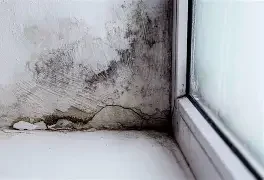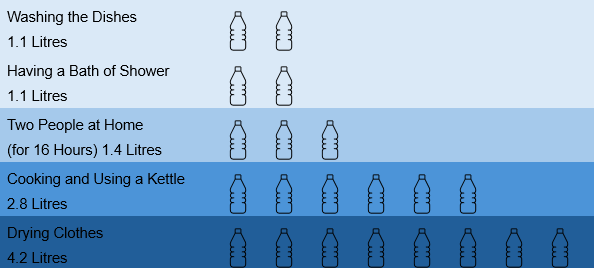Whether you are the landlord of a historic house or a modern build, damp can still be a problem - especially in the UK, where chilly, wet weather is the norm. Damp isn’t just annoying; it can lead to serious damage if left unchecked. So, how can you prevent it, and what should you do if it appears?
This guide explores practical ways to prevent damp and offers solutions for dealing with it if it’s already made an unwelcome appearance.
Landlords Data Sheet 1:
Understanding and Managing Damp in a Rental Property
The Scale of the problem
Damp remains a widespread and pressing issue across England, affecting an estimated 904,000 homes as of 2021. The private rented sector is particularly vulnerable, with 11% of properties showing signs of damp - significantly higher than the 4% in social housing and just 2% in owner-occupied homes. Most concerning is the impact on children, with nearly 790,000 living in damp-affected environments that pose serious risks to their respiratory health and overall wellbeing
What is damp?
Damp occurs when excess moisture builds up inside a property. It can be caused by rainwater seeping in, poor ventilation, or internal faults such as leaking pipes. If not dealt with promptly, it can compromise both the structure and the interior of a home.
Typical signs of damp include:
Dark patches or stains on walls
Peeling wallpaper or flaking paint
Persistent condensation on windows
Musty or stale odours
Cold walls despite heating
Rotting woodwork or flooring
White salt deposits (efflorescence)
Damage to fireplaces or structural features
Visible mould growth
Treating damp in properties starts with identifying the type - because each one requires a different approach. Misdiagnosing damp can lead to wasted time, ineffective repairs, and ongoing damage. That’s why it’s essential to understand the key differences between each type and apply the right solution from the start.
Condensation
This is the most common type, often caused by poor ventilation and excess moisture from cooking, bathing, or drying clothes indoors.
Typical signs:
Water droplets on windows or walls
Black mould spots, especially around corners or behind furniture
Musty smells in affected room
Treatment Tips:
Improve ventilation: install extractor fans, open windows regularly.
Use a dehumidifier to manage humidity.
Wipe down condensation daily
Insulate cold surfaces.
Apply anti-mould paint or damp-seal coatings to affected areas
Maintain consistent heating to reduce cold surfaces
Avoid drying clothes indoors without adequate airflow
Penetrating Damp
Caused by water entering through external defects—like damaged roofs, walls, or gutters.
Typical signs:
Damp patches that worsen after rain
Localised mould growth
Discolouration on walls or ceilings
Cracked render or damaged brickwork
Treatment Tips:
Repair cracks in walls
Seal gaps around windows and doors.
Clear gutters and downpipes to prevent overflow.
Repoint brickwork and fix damage
Improve drainage around the property
Rising Damp
This occurs when groundwater travels up through walls via capillary action—often due to a failed or missing Damp Proof Course (DPC).
Typical signs:
Tide marks or staining up to 1 metre high
Peeling paint or wallpaper
Crumbling plaster and damaged skirting boards
White salt deposits (efflorescence)
Treatment Tips:
Check for a functioning DPC and repair or install if necessary
Install or repair a DPC - this may involve chemical injections or physical barriers.
Apply damp-proof membranes to walls and floors.
Use electro-osmosis systems for severe cases.
Replace damaged plaster and redecorate with breathable materials
Lower external ground levels if bridging is present
Damp from Leaks
Caused by internal plumbing issues or appliance failures, leading to localised damp patches.
Typical signs:
Sudden appearance of damp or water pooling
Peeling paint or warped flooring
Dripping sounds or visible leaks
Treatment Tips:
Identify and fix the source of the leak promptly
Dry out affected areas thoroughly
Replace damaged materials if necessary
Monitor for mould growth during drying
Hygroscopic Damp
Moisture is absorbed from the air by salts left in building materials, often after previous damp issues.
Typical signs:
Persistent damp patches despite treatment
Salt staining on plaster or paint
No active water ingress
Treatment tips:
Remove and replace contaminated plaster
Use salt-resistant renders
Maintain low indoor humidity levels
Understanding Condensation in a home
Condensation is one of the most common contributors to damp and mould in residential properties. It’s often caused by everyday activities that release moisture into the air. The table below highlights how much water vapour is typically generated through routine household tasks - an essential reference for landlords aiming to prevent damp-related issues and maintain healthy living environments.
Tenant Awareness and Responsibility
Landlords should help educate tenants about how to prevent damp from the beginning of the tenancy. Providing a welcome pack with practical tips helps set expectations and encourages proactive behaviour. Tenants should understand the importance of regular ventilation, consistent heating, and reporting any signs of moisture or mould immediately. Open communication between landlord and tenant is essential to stop small issues from escalating.
Ventilate regularly – Open windows and doors for 15–20 minutes daily to allow airflow.
Remove mould promptly – Use mould spray or diluted vinegar and repaint with damp-seal paint to prevent recurrence.
Use extractor fans - during cooking and bathing to reduce steam build-up.
Adopt smart habits – Dry clothes outside, when possible, use lids while cooking, and switch on extractor fans.
Maintain steady heating – Keep indoor temperatures around 18°C during colder months to reduce condensation.
Leave internal doors open - (except when cooking or showering) to allow air to circulate freely.
Landlord Prevention Strategies
Install or supply dehumidifiers: These devices reduce humidity although remember dehumidifiers treat symptoms, not causes. Always fix the root issue first - whether it’s a leak, poor insulation, or lack of ventilation, then use the dehumidifier to manage residual moisture.
Renovations: Choose breathable materials during renovations:
Lime plaster instead of cement or gypsum
Polymer-based primers before decorating
Damp-resistant or natural paints
Bitumen coatings for brick or cement
waterproofing with butyl rubber or copper
Avoid plastic coatings, silicones, and epoxy resins
Hire professionals for damp-proofing: Experts can inject damp-proof creams or install systems like a Damp Proof Course (DPC) to prevent rising damp. Professional guidance is recommended to choose the right solution.
A legal Reminder
Landlords in the UK are legally required to maintain rental properties in a safe and habitable condition. This includes addressing damp and mould under several key laws:
Landlord and Tenant Act 1985 - Requires landlords to keep the structure and exterior of the property in good repair, including plumbing and heating systems. Damp caused by structural issues falls under this duty.
Homes (Fitness for Human Habitation) Act 2018 - Gives tenants the right to take legal action if their home is unfit to live in due to damp, mould, or other hazards. This law has empowered many tenants to seek compensation and repairs.
Housing Health and Safety Rating System (HHSRS) - Local authorities use this system to assess health risks in homes. Damp and mould are classified as Category 1 hazards, requiring enforcement action if found.
Awaab’s Law (Effective October 2025) - This landmark legislation was introduced following the tragic death of Awaab Ishak, a two-year-old who died from prolonged exposure to black mould in a housing association flat. Awaab’s Law mandates:
1. Emergency hazards (like severe mould) must be addressed within 24 hours
2. Non-emergency damp and mould issues must be resolved within a reasonable timeframe
3. Landlords who fail to act face legal consequences and potential compensation claim.
Penalties for Landlords Who Fail to Address Damp and Mould
Landlords who ignore damp and mould issues risk serious legal and financial consequences. Tenants have successfully taken legal action, with outcomes that often include:
Compensation for health impacts — including respiratory conditions, skin irritation, and mental health struggles linked to poor living conditions
Reimbursement for damaged belongings — such as clothing, furniture, and electronics affected by mould or excess moisture
Court orders for repairs and improvements — requiring landlords to carry out remedial works within a set timeframe
Fines and penalties — especially in cases of negligence, repeated complaints, or prolonged failure to act
Enforcement by local authorities — including improvement notices, hazard awareness orders, or direct intervention under the Housing Health and Safety Rating System (HHSRS)
Sources of Further Information
This guidance provides a basic overview of damp issues, recommended remediation methods, and the respective responsibilities of landlords and tenants. If you're experiencing damp, it's advisable to commission a professional assessment by a qualified expert - ideally an accredited surveyor from the Royal Institution of Chartered Surveyors (for example me!).
For further information and support, please refer to the resources linked below.
1. Guidance helps owners and tenants tackle damp and mould | Journals | RICS
2. Citizens Advice Guide on Damp
3. Shelter’s Legal Advice on Damp & Compensation
4. UK Parliament Guide for Tenants
5. Prepare for Awaab’s Law with Dewpoint Professional Training – Dewpoint ® Professional





